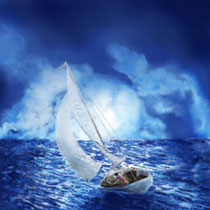These are the questions asked by museum curator
Zina Bercovici. The Romanian-born Bercovici, who moved to Israel 29 years ago, sees a strong connection between the season's darkest, deadest days and the region's brightest holidays. In 2011, the eight-day holiday of Hanukkah coincided with Christmas, amplifying the effect of light, she says.
She organized an international art exhibit around this idea, and also as a way to connect cultures for peaceful purposes. "I brought artistic works from 12 countries, from all religions, and the symbol of this exhibition is to connect all monotheistic religions - Judaism, Christianity and Islam - and show us how we can develop friendships between people all over the world. In art there is no politics, and it doesn't matter what religion you are. Artists like only to create their art and to give the message to people around the world that they want peace," says Bercovici.
The eight-day
Lights in the Winter exhibit at the Old Jaffa Museum of Antiquities featured 38 artists from countries such as Canada, Norway, Switzerland, Germany, the United States and Israel. It even included work by an Egyptian-born woman who now lives in Europe.
In the special light of winter
Lights in the Winter was a huge success over the eight days, attracting locals and tourists alike. Open from December 22 to December 29, this was a time when many Israelis were off for the holiday vacation and were out and about for family trips.
"In many cultures, the winter is celebrated with light to provide a contrast to the short, dark winter days and long nights," says Bercovici. "The winter light does not shine bright; it is soft and pastel, creating a warm and pleasant feeling. This period is a time for celebration in many cultures," notes Bercovici, who works as a freelance curator, organizing international exhibits from around the world.

Art by Jadranka Carluccio Grbic |
The exhibit included paintings, sculptures and photographs, all revolving around the theme of light in the winter. Some 80 works in total were showcased to illuminate the motif of winter lights and included the work of renowned artists such as David Kastner, Baruch Elron and Jadranka Carluccio Grbic.
All artists are prizewinners in their respective countries, Bercovici says, and their work is included in permanent galleries and museums around the world.
Most of the works highlighted were on loan, but one artist from Italy donated her piece to be auctioned for the benefit of children with cancer.
A museum worth 2,500 years
"I live in Haifa," says Bercovici, "but the area of Jaffa is a very special area. I like to organize exhibitions there because it is a symbol of the new and old and this connection looks very nice - the new contemporary paintings and sculptures near the old archeology pieces.
The Old Jaffa Museum of Antiquities is a non-profit organization supported by the Tel Aviv-Jaffa municipality. The space was chosen to juxtapose the old and the new, says Bercovici. The contemporary works set up beside the permanently installed ancient artifacts of the museum created an interesting effect.
"This is a massively powerful space," she says. Putting paintings and sculptures created in our time between ancient artifacts allowed her "to create tension and excitement in order to contribute an additional dimension to the subject of harmony between cultures and religions, which in my view is essential for peace."
The museum was built by the Ottomans on top of Templar ruins. In the 19th century it was a Turkish administrative and detention center, and today the building's five halls include artifacts uncovered in the city of Jaffa from the fifth millennium BCE up to the Arab period.
In the region of the museum are winding alleyways leading to ancient churches, synagogues and mosques, and getting lost in the small
Old City of Jaffa is a highlight for any tourist coming to visit Israel. It is a short walk to Tel Aviv and its beaches.